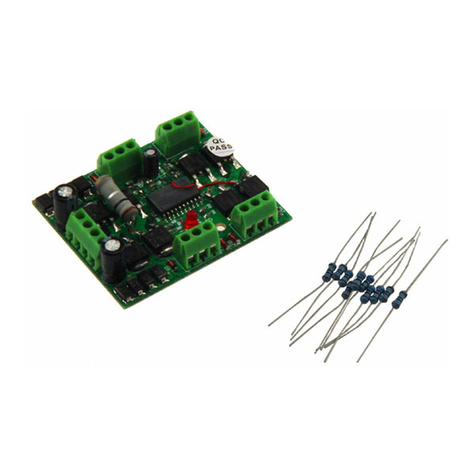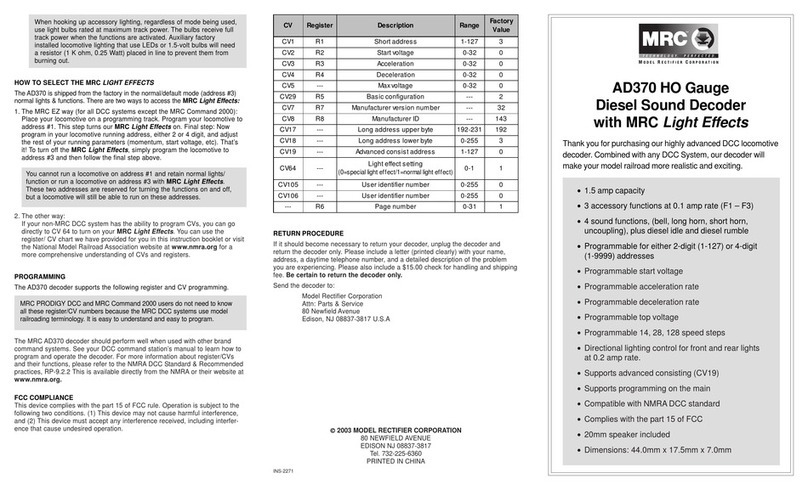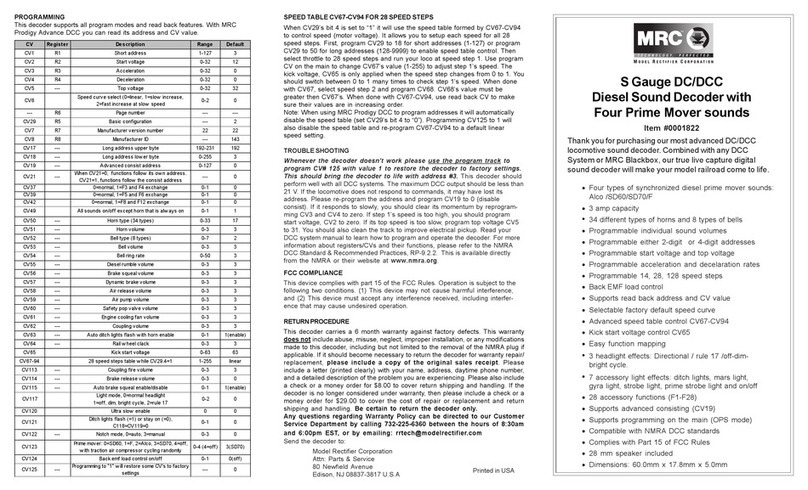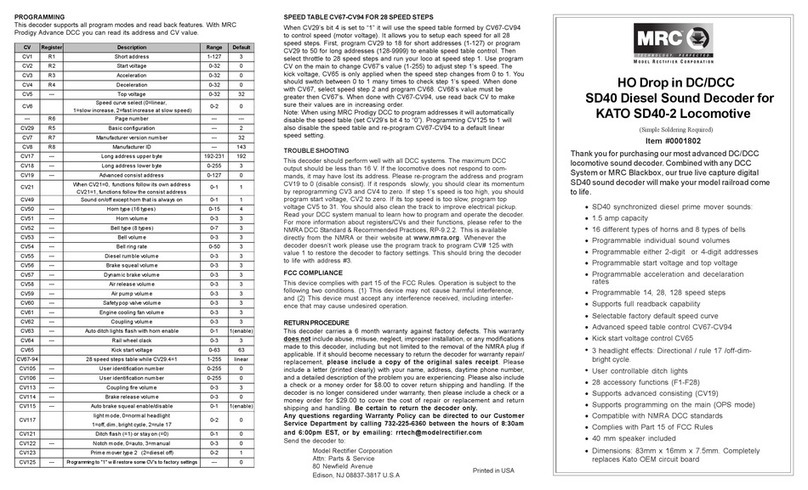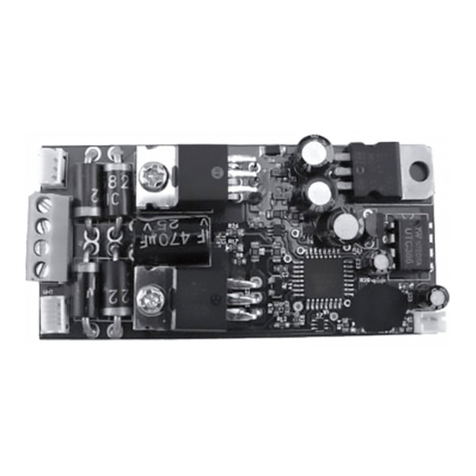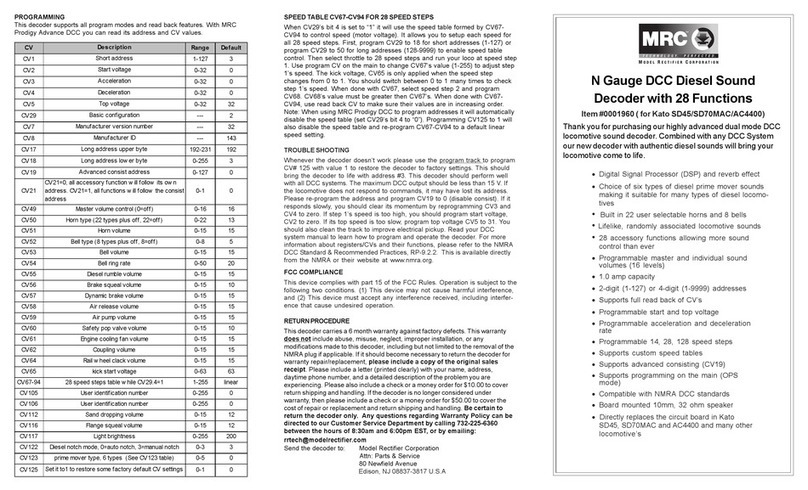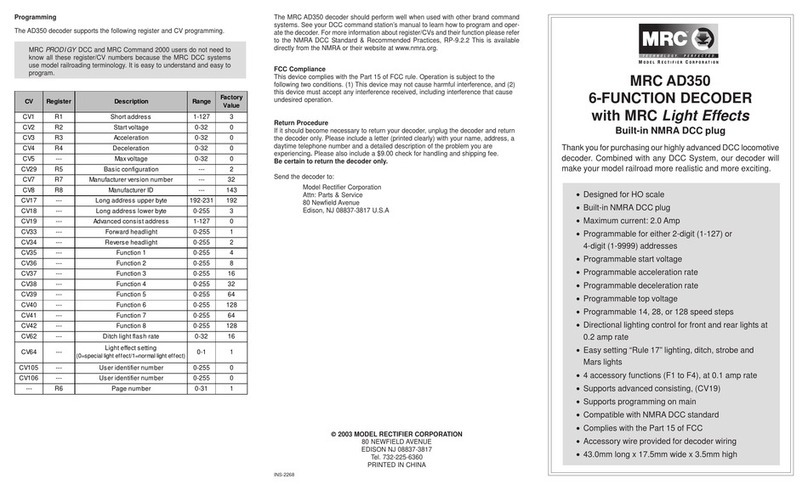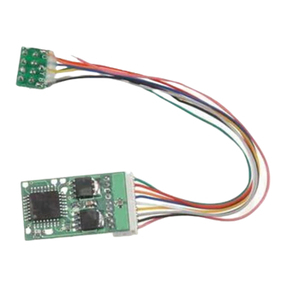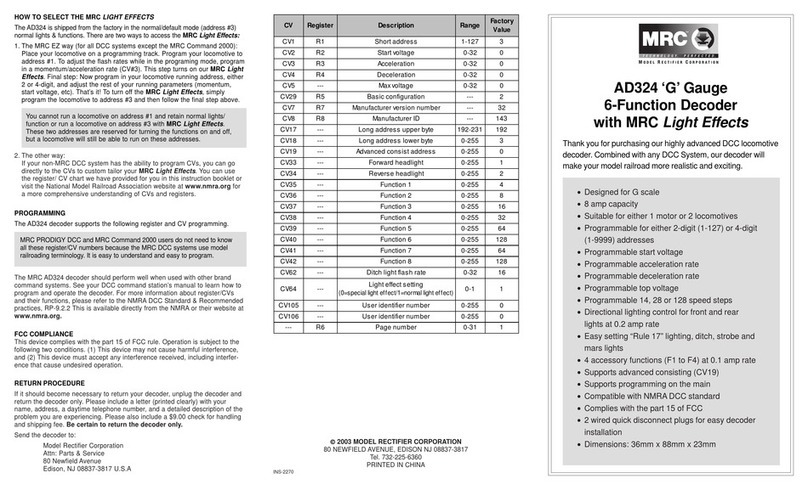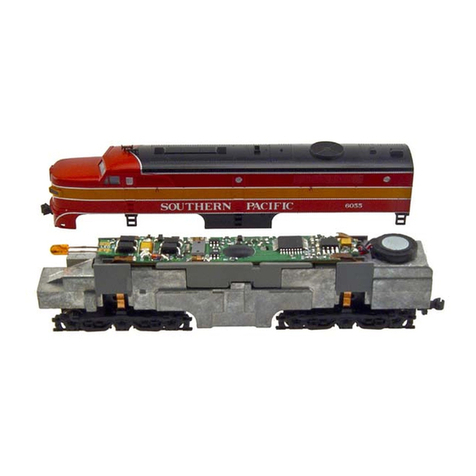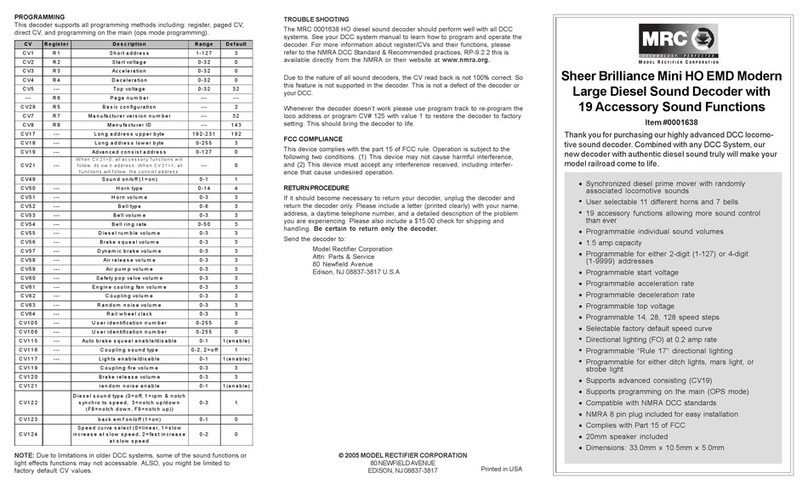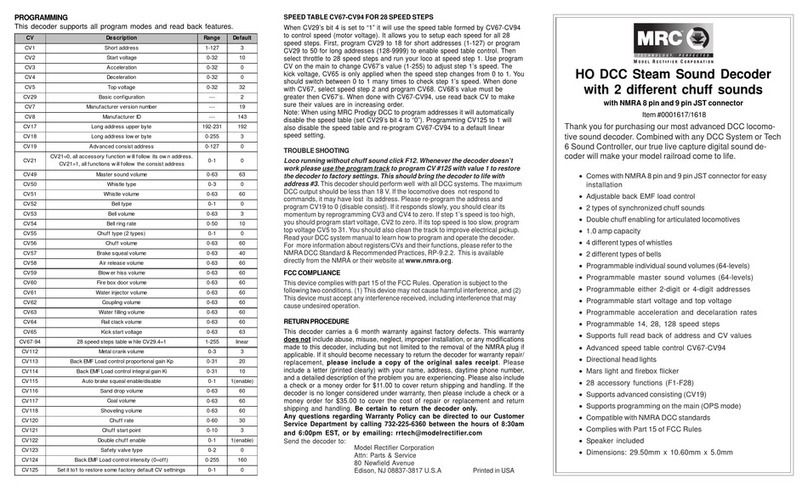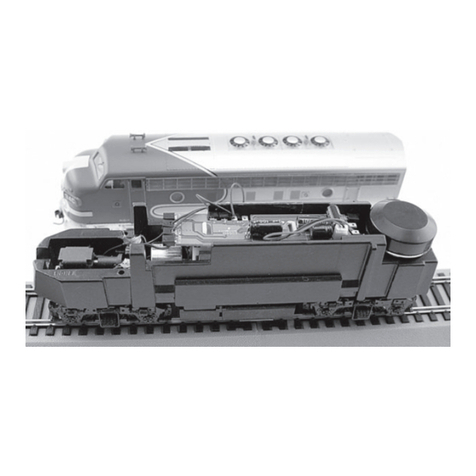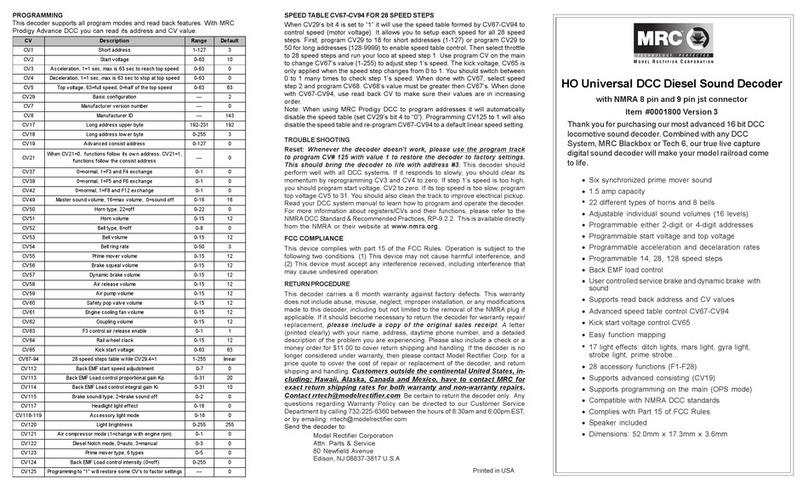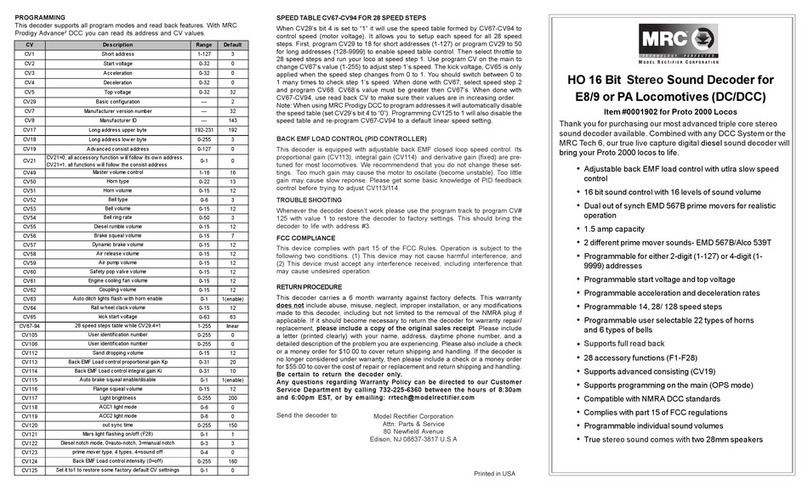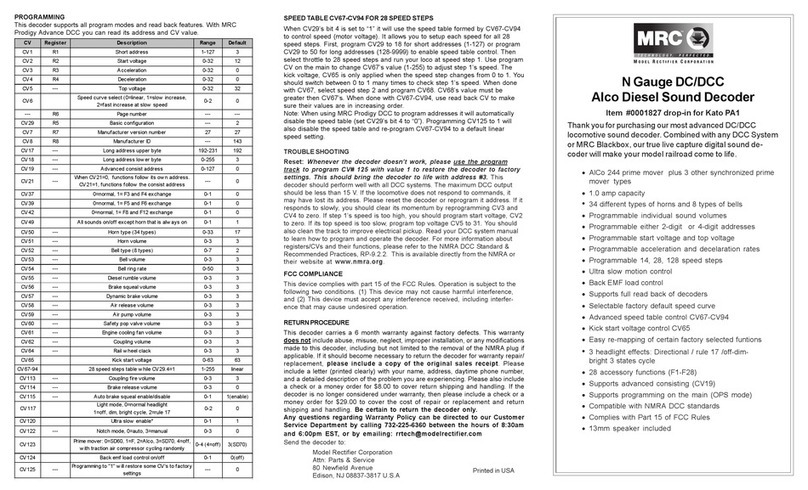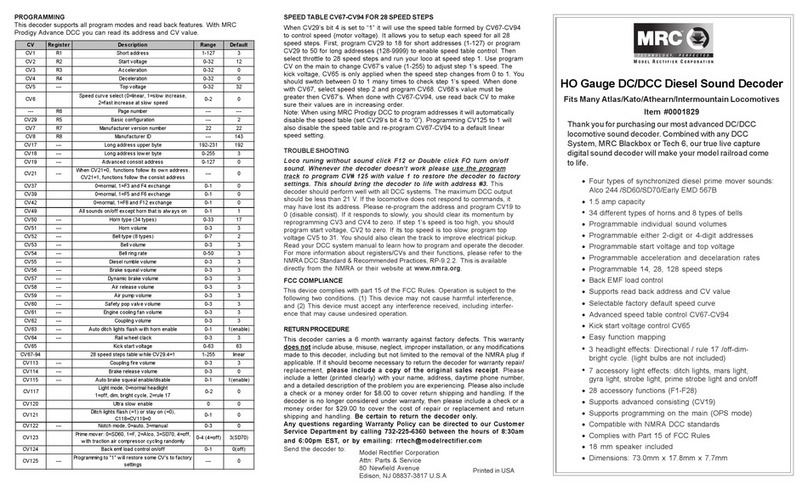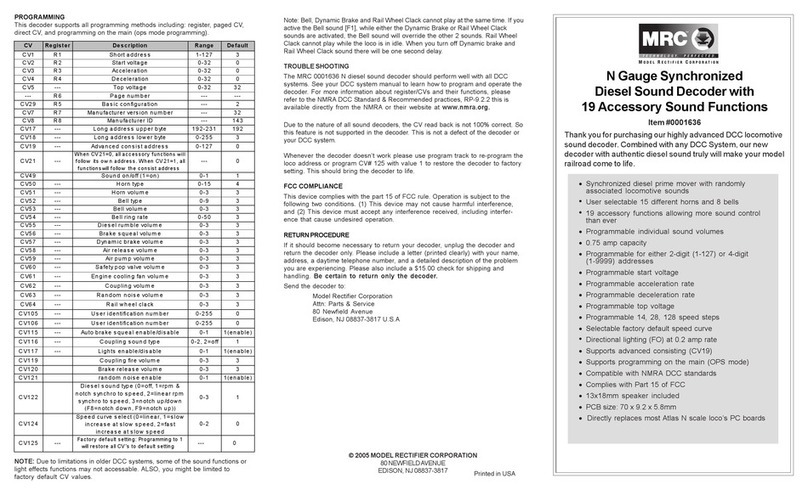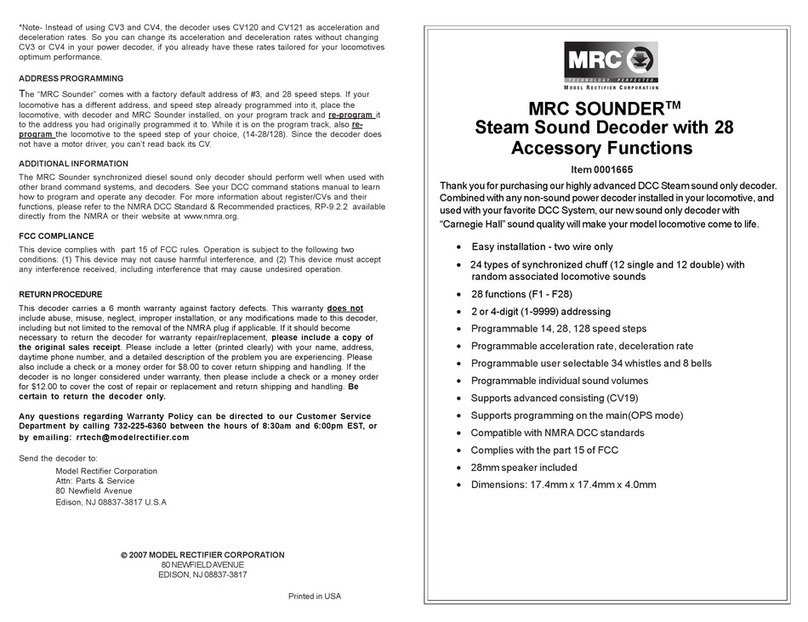
N Gauge Synchronized
Diesel Sound Decoder with
Two Authentic Prime Mover Sounds
Item #0001955
Thank you for purchasing our most advanced 16 bit DCC
locomotive sound decoder. Combined with any DCC System,
our new decoder with authentic diesel sound truly will make
your model railroad come to life.
•Two selectable diesel prime mover types with
randomly associated locomotive sounds
•User selectable 22 different horns and 8 bells
•28 accessory functions allowing more sound control
than ever
•Programmable individual sound volumes (16 levels)
•0.75 amp capacity
•Programmable for either 2-digit (1-127) or 4-digit
(1-9999) addresses
•Programmable start voltage and top voltage
•Programmable acceleration and decelaration rates
•Programmable 14, 28, 128 speed steps
•Selectable factory default speed curve
•Supports full read back
•Supports advanced consisting (CV19)
•Supports programming on the main (OPS mode)
•Compatible with NMRA DCC standards
•Complies with Part 15 of FCC
•10mm speaker included
•drop in fits Atlas N scale GP7, GP9, GP30 and GP35
PROGRAMMING
This decoder supports all program mode and read back feature. With MRC Prodigy
Advance DCC you can read its address and CV value.
SPEED TABLE CV67-CV94 FOR 28 SPEED STEPS
When CV29’s bit 4 is set to “1” it will use the speed table formed by CV67-CV94 to
control speed (motor voltage). It allows you to setup each speed for all 28 speed
steps. First, program CV29 to 18 for short addresses (1-127) or program CV29 to 50
for long addresses (128-9999) to enable speed table control. Then select throttle to
28 speed steps and run your loco at speed step 1. Use program CV on the main to
change CV67’s value (1-255) to adjust step 1’s speed. The kick voltage, CV65 is
only applied when the speed step changes from 0 to 1. You should switch between 0
to 1 many times to check step 1’s speed. When done with CV67, select speed step
2 and program CV68. CV68’s value must be greater then CV67’s. When done with
CV67-CV94, use read back CV to make sure their values are in increasing order.
Note: When using MRC Prodigy DCC to program addresses it will automatically
disable the speed table (set CV29’s bit 4 to “0”). Programming CV125 to 1 will
also disable the speed table and re-program CV67-CV94 to a default linear
speed setting.
TROUBLE SHOOTING
This decoder should perform well with all DCC systems. The maximum DCC
output should be less than 15 V. If the locomotive does not respond to com-
mands, it may have lost its address. Please re-program the address and program
CV19 to 0 (disable consist). If it responds slowly, you should clear its momentum
by reprogramming CV3 and CV4 to zero. If step 1’s speed is too high, you should
program start voltage, CV2 to zero. If its top speed is too slow, program top
voltage CV5 to 31. You should also clean the track to improve electrical pickup.
Read your DCC system manual to learn how to program and operate the decoder.
For more information about registers/CVs and their functions, please refer to the
NMRA DCC Standard & Recommended Practices, RP-9.2.2. This is available
directly from the NMRA or their website at www.nmra.org. Whenever the
decoder doesn’t work please use the program track to program CV# 125 with
value 1 to restore the decoder to factory settings. This should bring the decoder
to life with address #3.
FCC COMPLIANCE
This device complies with part 15 of the FCC Rules. Operation is subject to the
following two conditions. (1) This device may not cause harmful interference,
and (2) This device must accept any interference received, including interfer-
ence that may cause undesired operation.
RETURN PROCEDURE
This decoder carries a 6 month warranty against factory defects. This warranty
does not include abuse, misuse, neglect, improper installation, or any modifications
made to this decoder, including but not limited to the removal of the NMRA plug if
applicable. If it should become necessary to return the decoder for warranty repair/
replacement, please include a copy of the original sales receipt. Please
include a letter (printed clearly) with your name, address, daytime phone number,
and a detailed description of the problem you are experiencing. Please also include
a check or a money order for $9.00 to cover return shipping and handling. If the decoder
is no longer considered under warranty, then please include a check or a money order
for $35.00 to cover the cost of repair or replacement and return shipping and handling.
Be certain to return the decoder only.
Any questions regarding Warranty Policy can be directed to our Customer
Service Department by calling 732-225-6360 between the hours of 8:30am
and 6:00pm EST, or by emailing: rrtech@modelrectifier.com
Send the decoder to: Model Rectifier Corporation
Attn: Parts & Service
80 Newfield Avenue
Edison, NJ 08837-3817 U.S.A
CV Register Description Range Default
CV1 R1 Short address 1-127 3
CV2 R2 Start voltage 0-32 10
CV3 R3 Acceleration 0-32 0
CV4 R4 Deceleration 0-32 0
CV5 --- Top voltage 0-32 32
CV 6 Speed curve select (0=linear, 1=slow increase,
2=fast increase at slow speed) 0-2 0
--- R6 Page number --- ---
CV29 R5 Basic configuration --- 2
CV7 R7 Manufacturer version number 27 1
CV8 R8 Manufacturer ID --- 143
CV17 --- Long address upper byte 192-231 192
CV18 --- Long address low er byte 0-255 3
CV19 --- Advanced consist address 0-127 0
CV49 odd number sound on, even sound off 1on
CV 50 - - - Horn type 0-22 6
CV 51 - - - Horn volume 0-15 12
CV 52 - - - Bell type 0-7 3
CV 53 - - - Bell volume 0-15 12
CV 54 - - - Bell ring rate 0-50 3
CV 55 - - - Diesel rumble volume 0-15 12
CV 56 - - - Brake squeal volume 0-15 7
CV 57 - - - Dynamic brake volume 0-15 12
CV 58 - - - Air release volume 0-15 12
CV 59 - - - Air pump volume 0-15 12
CV 60 - - - Safety pop valve volume 0-15 12
CV 61 - - - Engine cooling fan volume 0-15 12
CV 62 - - - Coupling volume 0-15 12
CV63 --- Sand release volume 0-15 12
CV64 --- Rail wheel clack 0-15 12
CV 65 Start Kick voltage 0-15 12
CV67-94 28 speed steps table w hile CV29.4=1 1-255 linear
CV112 Air compressor volume 0-15 12
CV113 --- Coupling fire volume 0-15 12
CV114 --- brake release volume 0-15 0
CV115 --- Auto brake squeal enable/disable 0-1 1(enable)
CV116 --- Flange volume 0-15 12
CV122 --- Notch mode, 0=auto, 3=manual 0-3 0
CV123 Prime mover type and off 0-1 1(on)
CV125 --- Programming to "1" w ill restore some CV's to
factory settings --- 0
0CV 21 - - -
When CV21=0, functions follow its ow n
address. CV21=1, functions follow the consist
address
---












